Calculadoras Calculator blog Mensajes sobre el tema: wp34s
Calculator blog
Musings and comments about our common interest
Offers for Black Friday - 2
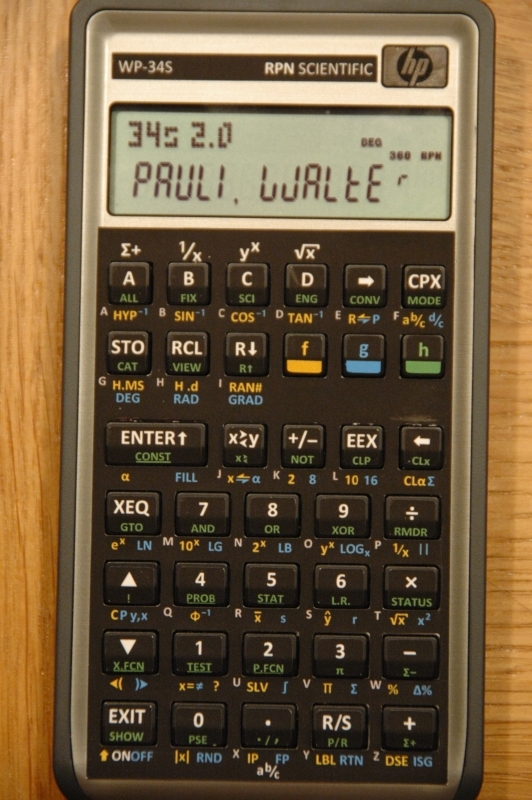 Since the HP42s, then has not been any significant development in Scientific calculators, at least in the RPN flavor. When HP released the HP30b calculator, it provided also a Software Development Kit with it. The machine used a well known third party chipset, and had a Pogo connector for upgrading software. Some aficionados saw the opportunity of creating the best RPN calculator ever.
Since the HP42s, then has not been any significant development in Scientific calculators, at least in the RPN flavor. When HP released the HP30b calculator, it provided also a Software Development Kit with it. The machine used a well known third party chipset, and had a Pogo connector for upgrading software. Some aficionados saw the opportunity of creating the best RPN calculator ever.New version of wp34s: 3.3
The wp34 has just received a new upgrade. It goes now from 3.3 version to 3.4. As I did no follow it too closely, I don't know the improvements to this version. It uses the same key scheme as the previous one, so the only thing that you need to do is to upgrade the software again.
For those of you that don't have an interface cable, don't worry: our shop can upgrade your calculator for 12 € per unit, plus shipping costs. Just email us at sales@thecalculatorstore.com and we’ll organize it.
We can also upgrade from version 2 machines, but in this case it needs to be necessarily more expensive, since the keys are different and you need a new key set. (There is an additional problem in removing the previous one - I have not managed to do it properly on mine, so I cannot vouch for aesthetic perfection.)
For those that want a RPN scientific calculator, there is nothing better under the sun, short of an HP 41cl (and yet, the wp34s is much faster and has a much bigger feature set at your fingertips). The double accuracy capabilities are unmatched for a calculator; and the constant set makes it excellent for any lab work. The hp prime is more nice to show to others, it can help you with algebraic maneuvering and is much better to use if you're a student; but when it comes to raw computing power, there is no substitute for the wp34s.
It is surprising that development is ever continuing, given that the designers are head on into a different, much more ambitious project, namely the wp43s, a calculator from scratch. We will inform you about that too.
(Meanwhile, Monte seems to be breadboarding a solution to bring the Time Module to the 41CL system. Let's see where it ends!)
The HP30b
Now that I am working a lot with the HP Prime, using the little tips and user keyboard, I am getting used to the low displacement, clear click of the HP Prime family. "When was the last time I felt a click like this?", I ask myself. And the answer is clear - in the Hp 30b Financial Calculator.
This little machine has never enjoyed the cult status of the other machines: both the 12c/cp family (with their classic keys with three functions in each, and programmable in RPN), or the HP17bII+, with its very good keyboard feel and intelligent solver, which can be turned in a programming language with a little knowledge and ingenuity, have enjoyed a "top" status that the 30b did not reach.
And the 30b is the fastest of them all, and as well the one that has a better set of functions - but that you know only when you have bought it, not before. Its menu system, while not as "beautiful" as the one from the HP17bII+, is well organized, and you can perform solver-like calculations in one of its mini-solver 3- or 4- variables calculator. You can even perform Black and Scholes calculations off-the-shelf - a first for an HP calculator. Both the HP12c and the HP17bII could do it; the first one, fully using the 99 memory steps (in a program made, I think, by Pablo Fernández, engineer and Finance professor in IESE MBA); the second one, via some complex programming of the solver.
But as well, it is the ideal statistical calculator. Apart from creating lists of points, which is much better that just feeding some accumulators like the previous calculators did (apart from the HP17bii), it has a set of "descriptive statistics", another set of data fit in many types (many more than the ones that appeared in the statistic pacs of the HP 41c), then the typical accumulator set (that we have from the very first HP calculator that had statistical functions) and another set of quartile analysis. If you look at the manual (pages 69 and onwards) you will see all of them in a very clever "function map".
The front panel is made obviously made of plastic - the metallic aspect, while elegant from far, and resistant to scratches, fools no one. It cannot be compared with the nicer livery of the HP17bII.
The screen, while much more descriptive than the one on the 12c family, has an alphanumeric upper part (where you see the function you're performing or the place in the menus your into now), and a numvrica part, but not made of dot-matrix characters, but with segments instead. Curious. It is much clearer than a dot matrix display, but it seems odd in these times of "retina" displays.
(I always forget to state that one of the advantages of a calculator is that it is nearly impossible that it runs out of power while you're at a critical situation like an exam. I almost also forget to tell you that it can be algebraic OR RPN !!)
We have lowered its price to 40€. Now we have plenty - probably more than what we could convert to wp34s (which is another of the beauties of this little machine!). I leave here a good picture of it, for you to enjoy.
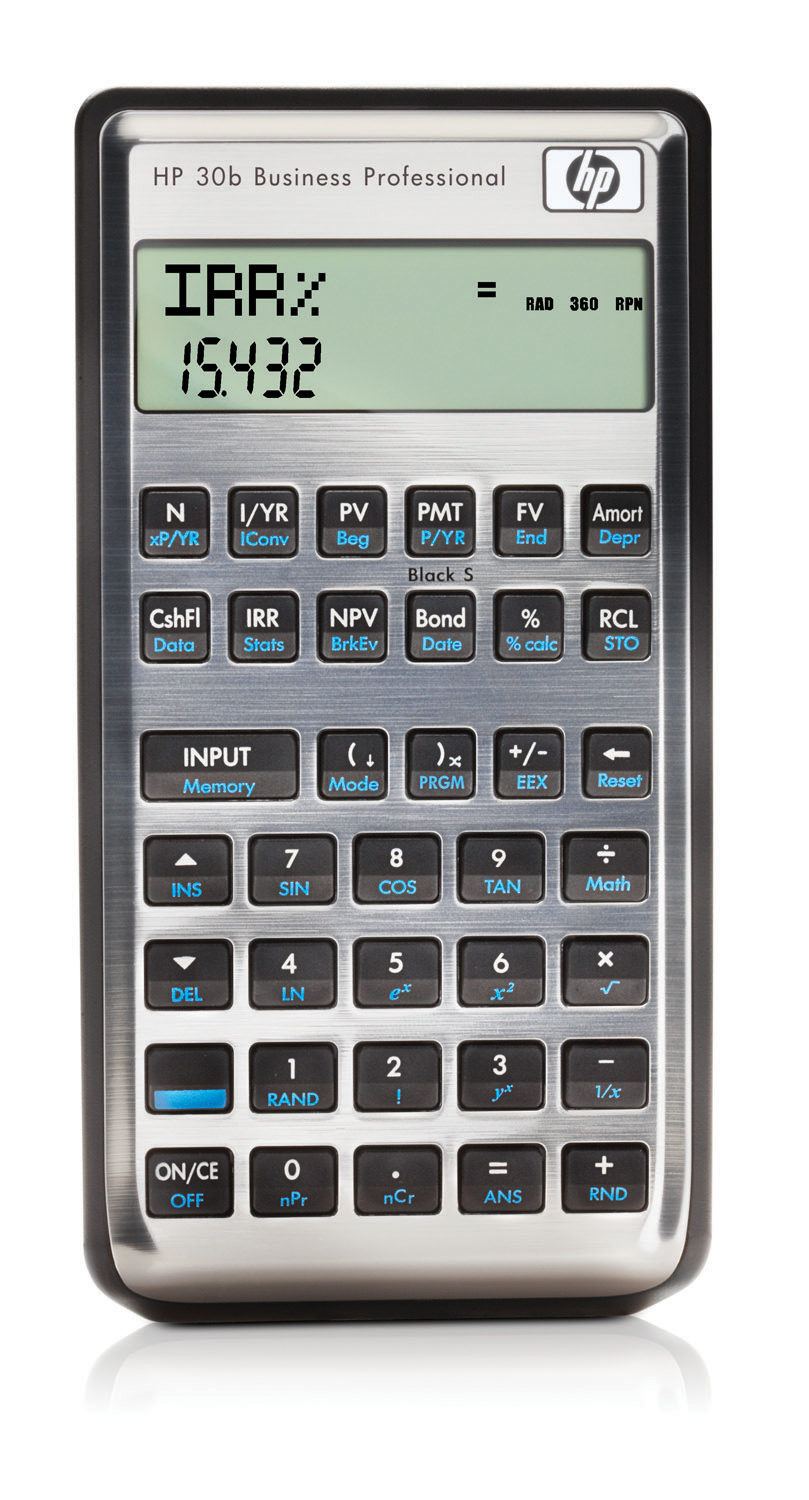
An attractive moment for calculator lovers
There are at this moment three interesting calculator development areas for us, and some other minor interesting possibilities:
- The new calculators from HP. The work behind the development of the new family of HP calculators is enormous, and it implies a significant commitment from HP. The prospect of the HP Prime is magnificent. I look forward to use it to teach maths to my children. The HP39gII is already an excellent tool - if crippled by the lack of CAS (but this was a requirement of that particular market. Let’s not forget that China is the goal of that calculator, and that there are several big markets where it is not distributed), but the HP Prime is several levels higher. It covers the space between the textbook and wolfram; you need to spend significant money in iPad apps to get to that level. And, for a classroom, it has the advantage over the iPad that you CAN’t use it to browse the internet and otherwise distract your pupils. (In technobabble, “the killer feature is that it does not have a browser”)
- The HP41CL. For those of us that are well over 40, this calculator was a part of our lives. There were many things that we did with it, we can create simple programs to ease our common calculations with our eyes closed, and it has the best keyboard feel of them all (of all practical calculators - there is a lot of pleasure to be had with the HP67 and HP97 calculators, but the lack of permanent memory makes them a no-no for daily work). The HP41CL allows us to do everything we wanted to do and could not afford at that time. For the price of 4 modules in the auction sites, you can have them all; and you can flash more on top; and everything runs up to 50 times faster.
- Our community projects, of which the WP34s and the WP43s project are the best example. Everything I have seen from the WP43s project is impressive, and competitive with any offer in the market. I really think there is room for a proper RPN calculator that can be used without mastering a doctor’s degree in computing. The HP42s was the last of that era; and while the WP43s is fantastic for what it does and clearly superior many others, it lacks the easy of use and interface of the former. Of course, this is not the fault of the creators, due to the limits of the platform used (the HP30b), in particular its lack of on-screen function keys and the limited resolution (and ugliness) of its segment-based screen.
Summing it all, it is a fantastic time to be in this business. Let’s remember that it was close to dead several years ago…Now we only need someone to realize that there is a permanent space for the HP15c LE - taking into account that the development is all done and there are no more costs to bear (some bug fixing would be great but not really required!)
Scientific Calc's Collector's Pack
Scientific Calcs Collector’s Pack
In a previous blog page, I told you that many of our customers are calculator collectors as well. Many of them will not stop until completing their collection. And some of them have just decided to start theirs. These packs are for them.
Although HP calculators started by scientific models, they soon completed the line with financial models, distinguished by the Time Value of Money algorithm. Over time, HP has mastered this market, while during the 90’s they lost the scientific market to Texas and others. Since HP is so strong in financial calcs, we started these packs by the financials. You can see them here.
Now is the turn for the scientific. We have assembled the HP standard scientific models, and we have added as well the brand new kid in the block: the wp 34s, based on HP30b hardware.
The units included in this pack are:
- HP10s
- Smartcalc 300s
- HP30s
- HP35s
- HP15c
- WP34s with latest firmware
There are a very limited number of units of 15c (150 in total, and HP told us they would not produce any more), and as well we have difficulties to locate HP30s over 70 units. So you need to make up your mind!
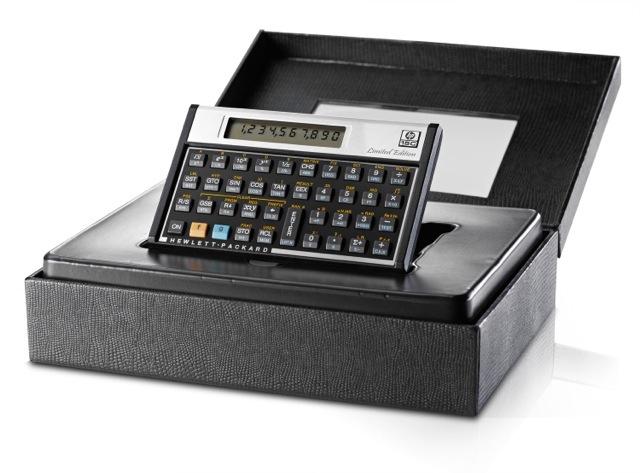
The true HP connoisseur will know that both the 10s, the Smartcalc300s and HP30s have not 100% HP pedigree; they cannot be used in RPN mode. I have a hard time using a non-RPN calculator, so these units will see limited use on my desk; but as a collector, I need to have them all.
If I had enough supply of classic units, I would include them; but as I seldom have more than one or of each (and often one of them belongs to MY collection), I cannot include them in the pack.
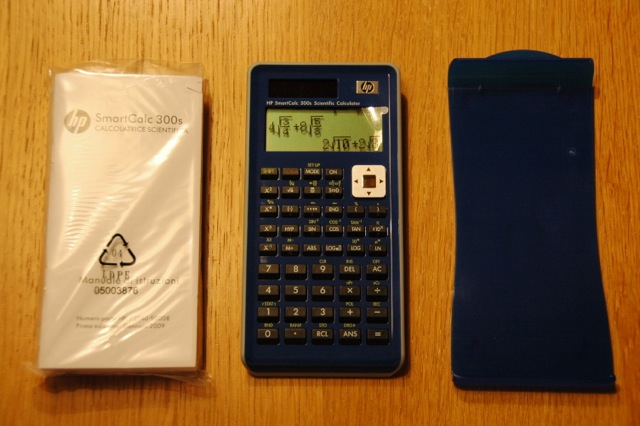
wp34s - part 1
WP34s - a work in progress - Part I
The wp34s is a DIY attempt to replicate (and even improve upon) the HP42s, probably the best RPN calculator ever. Perhaps a little history is in order.
Hewlett-Packard created the programmable calculator market from scratch. The Hp65 first, and then the HP67, were the best calculators of their age, and they were the first to provide mass storage (if I remember correctly, "mass storage" means here a meagre 256 bytes. It is important to grasp the magnitude of this value: it is 1.000.000.000 times smaller than the hard disk of my Mac.
You really needed to be quite compact in your coding to be able to do something with that amount of memory. Well, in any case these were the best available handheld devices of their time and made their way to many spaceflights. There is even a website devoted to the HP calculator space history.
Then, the alphanumeric HP41c arrived.
It was purported as a handheld computer, and it was expandable - there was an enormous amount of peripherals and options, which made it able to do most handheld work of that time. Every one at that time wanted to have one - but not many could. On the other hand, the hp41c was barely pocketable; and the fact that many of its functions had to be addressed from the XEQ button made it less of a calculator. You really had to know the function catalog by heart to be able to take it to the maximum. Even though, and when you mastered, you had to type XEQ Alpha function keys Alpha - not very user-friendly.
In that respect, and in my humbler opinion, it was not as good as a pure calculator as its predecessors. As it was 100% customizable, you could reassign the hidden functions to the keys of your choice, and you even had removable keyboard overlays to show them - but it always left me with a feeling of DIY.
It also was limited in the number of functions and how they were implemented. Matrices and complex numbers come up to mind. Complex in particular were implemented in several HP and third party modules - but these were not compatible among themselves and in many cases led to just 2 stack levels available - not the right thing when you're calculating circuits!
Then the HP15c came. In many areas a step back from the HP41c (not expandable,not alphanumeric, programs stored as key codes, small memory area), it was a true handheld pure calculator. It had matrices and complex numbers done right, all functions were accessible from the front panel, and it could really fit in your shirt pocket.
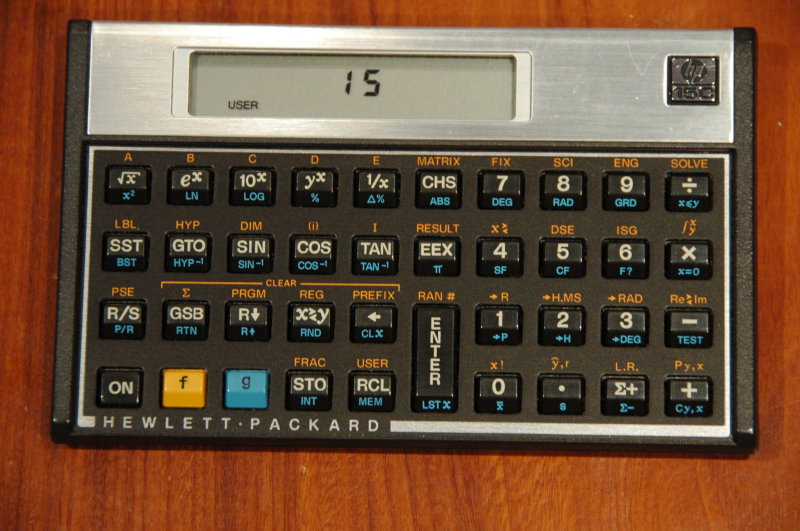
Still, many of us perceived it as second rate compared with the HP41c. We were comparing real world (hp15c) with potential capabilities when expanded (hp41c). Now, with perspective, I see that the 15c is the better calculator (not the better computer, not the better lab device, but the better calculator)
Then, HP released the HP71c - a true BASIC computer in calculator size, and later the HP28c, which was the first RPL device, and the distant root of both the Pioneer and HP48 families. Still, the HP41c remained the workhorse of the HP calculator family. Adding complexity to devices made them more suitable for class use - not necessarily for professional use.
When confronted with the aging but still bestseller HP41c, HP thought that there should be a software-compatible calculator, based in modern hardware, but still appealing to the HP41c calculator base. It should still be RPN, as opposed to the new series of calculators; and it should offer a better way of reaching the additional functions that the XEQ method.
The answer to that need was the HP42s. It had nearly total software compatibility with the HP41c, but it also had a menu-driven interface for the additional functions, and it integrated complex mathematics and matrices in a seamless way - much better even than with the hp15c; in fact, in my opinion, better than any other calculator, past or future. It had also a way of using the solver function and menus in normal programming. It also allowed techniques for keeping your stack safe when you were using programs.
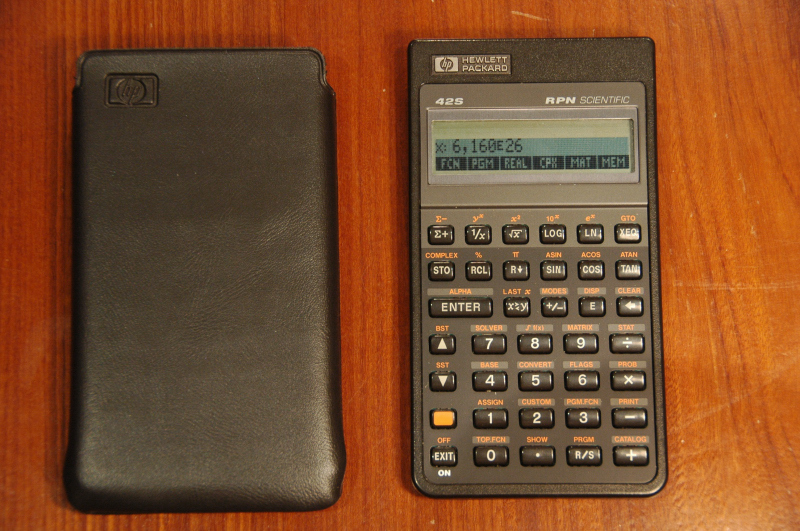
(It was an irony, though, that the little machine, the zenith of RPN, was itself programmed in SysRPL)
Later, the HP48 family appeared, but it was already a different animal: unlimited stack, different object types, a more complex programming environment (elegant, but too different from the current programming mainstream to be able to grab attention). It was expandable, but not in the same way as the HP41c was. In fact, that kind of expandability has not been reached later. The fact that Agilent was spun off later made impossible to add instrument connectivity.
So that left us without continuation to the top RPN line. Later HP RPN calculators (like the HP32 in their various guises, the HP33s and the HP35s) do not hold a candle to the HP42s)
When HP issued the HP12c running as an emulation in an ARM processor, there was hope for us that HP could release a follow up of the HP42s. However, the kind of screens that could be driven from this processor were not as complex as the dot-matrix one used in the pioneer series like the HP42s. I questioned HP about their likelihood to produce an HP42s, since both the screen and the keyboard live on the HP17bII+. It seems that this is a closed avenue, since the processor used in that series could not seriously run the HP42s firmware; and the whole enterprise would be a significant R&D commitment, not worth in the current scheme of things.
Simultaneously, HP had issued a number of calculators using the SRM processor, and a way to modify it through a serial connector on the back: the HP20b and 30b. These were financial models, and quite powerful at that: as they are programmed in "native" code, and not running an emulator, they are the fastest HP calculators around, even faster than the HP50g in RPL.
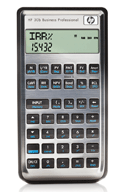
It was in this situation that Paul Dale and Walter Bonin set to produce a RPN calculator (to be continued in part II)
The WP 34s is back!
The wp34s is back!
Finally we received the overlays of the current approved design and we are ready to update the firmware of brand new HP30b s into the most powerful RPN calculator ever - with permision from the mighty HP42s
Eric's newer overlays are better than the previous, initial batch. You can choose between coloured shift keys or white; and you can choose as well between both division signs: / and the two dots with a dash in the middle. All are in the overlay for you, the user to choose.
There has been significant evolution since we updated the first calculators - now you can do matrix operations with them as well.
WP34s
Well, I have run out of overlays for HP34s for the first time!
Today I had to return a payment from a customer in the US for a WP34s. For those that have placed an order, do not worry - we are honouring the orders!.
We have modified the website so that the wp34s cannot be ordered until we have more overlays. Thank you all for your confidence.
SIMPLEX Algorithm and the transport problem
On anothe note: as we are now changing our logistic network completely, I am starting to re-enter in the operational programm, I plan to play ing area - the "transport problem", SIMPLEX, etc. I have found that the HP 50g is exceptionally suited to these programs. Since the number of possible routes is not enormous, we plan to play with it. The savings in the different models tested by hand are very significant - let's see. We're talking about hundreds of thousands. Programming is not 100% deterministic - there are specific customers with specific requirements, phobias, philias, etc.
One thing amazing about linear programming for the HP50g is that most of the software I have found is in Spanish - is there any reason for that? I guess that SIMPLEX algorithm is favoured in Spanish speaking engineering schools, other different algorithms being used in other countries. Can any reader illustrate me on this area?
WP 34s just born
Finally!
I received this week the overlays from Eric Rechlin. Wonderful quality and choice of material. You cannot touch it from where you are - believe me that feeling is good and adherence superb:
I have received several overlays. I plan to set the complete kit: the flashed HP30b + the overlays. Just to Europe to avoid competition with Eric; and 10 € of each sale will be donated to the wp34s project.
Now, let's see the machine under surgery:
It was updated with the latest available build, 1125 at the time:
Now, let's see how it ended up:
Sorry - the light condition was low and my pulse unstable -> fuzzy picture.
This one is better:

When you do it, do not try to fix it with a hard thing - see the mark over the CLx key.
I learned from it and the rest of the keyboard was excellent!!
It really looks professional, and the key feel is much better than the HP20b.
Now, let's try to work with it and make some programs !!!



